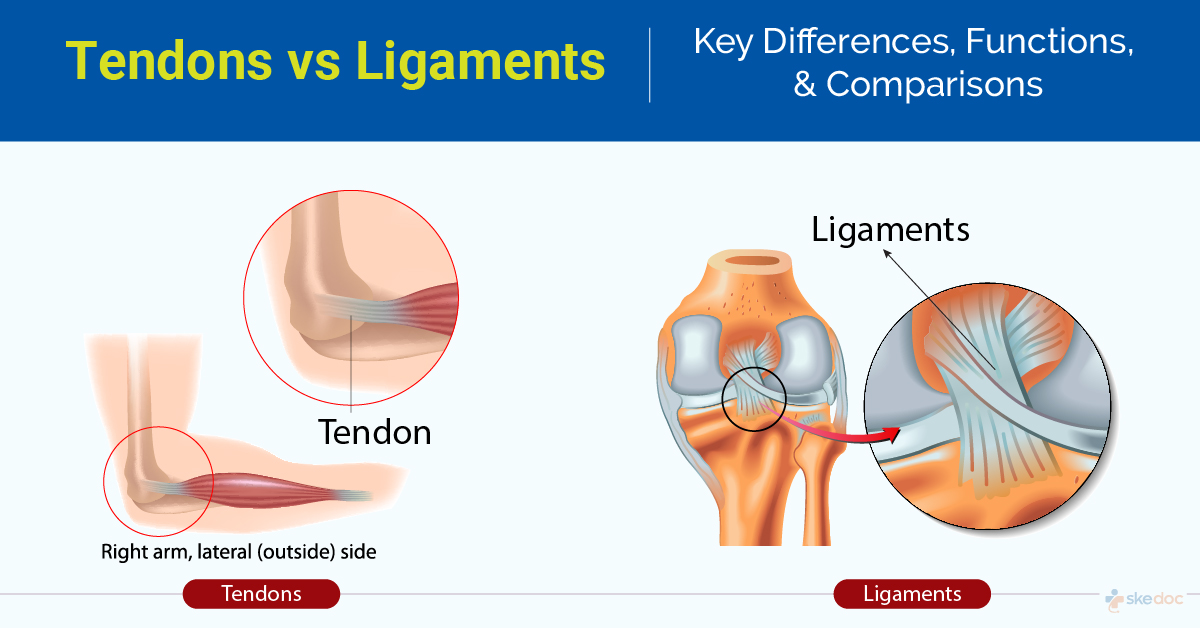Allergy
Blood Diseases
Bone & Joints
Brain
Cancer
Child Care
Cosmetic Surgery
Diabetes
Endocrinology
ENT
Eye
Gen Medicine
General Surgery
Heart
Kidney
Lifestyle
Liver & Digestive
Lung
Men’s Health
Mental health
Physiotherapy
Rheumatology
Skin and hair
Sleep Disorders
Spine
Transplant
Women Health
Thyroid
Vascular Surgery
Tendons vs Ligaments

Introduction
Tendons and ligaments are essential components of the musculoskeletal system, each playing a crucial role in supporting movement, stability, and overall bodily function. While these connective tissues share similarities, understanding their unique characteristics is vital for comprehending how they contribute to the body's mechanics. This article delves into the anatomy, functions, injuries, healing processes, and preventive measures associated with tendons and ligaments.
Anatomy and Structure
Tendons and ligaments, composed of fibrous connective tissue, have distinct structures tailored to their specific functions. Tendons connect muscles to bones, resembling sturdy cords that transmit the force generated by muscle contractions to move the skeletal system. On the other hand, ligaments connect bones to other bones, forming a network of bands that provide stability to joints.
The composition of tendons includes collagen fibers arranged in parallel bundles, granting them resilience and strength. Ligaments, while also containing collagen, have a more complex structure with a crisscross pattern that enhances their ability to withstand multidirectional forces within joints.
Functions in the Body
Tendons and ligaments collaborate to ensure smooth and coordinated movement while maintaining stability in the musculoskeletal system. Tendons, acting like efficient transmission lines, enable muscles to exert force on bones, allowing us to perform activities ranging from simple gestures to complex physical tasks. Ligaments, on the other hand, prevent excessive movement in joints, providing crucial support and preventing dislocations.
Tendons
- Transmission of force: Tendons are the vital link between muscles and bones. They act like cables, transmitting the force generated by muscle contractions to bones, enabling movement. Imagine them as the gears of your body, translating the power of your muscles into concrete actions.
- Variety of movements: Tendons facilitate a diverse range of motions, from the intricate movements of your fingers to the powerful contractions of your legs during running. They allow us to perform daily activities with ease and precision.
- Storage and release of energy: Tendons possess a unique ability to store and release elastic energy. When muscles contract, tendons stretch, storing the generated energy. This stored energy is then released during the relaxation phase of the muscle contraction, contributing to the efficiency and explosiveness of movement.
Ligaments
- Joint stabilization: Ligaments guard our joints, securing bones together and preventing excessive movement. They act like strong bands, providing crucial support and preventing dislocations or instability. Think of them as the safety locks on your doors, ensuring the structural integrity of your joints.
- Joint proprioception: Ligaments play a vital role in proprioception, our sense of body awareness. They contain specialized receptors that send signals to the brain about the position and movement of our joints, allowing us to coordinate our movements with precision.
- Limiting range of motion: Ligaments act as natural limiters, preventing joints from moving beyond their intended range. This helps to protect the joints from damage caused by overextension or hypermobility.
Tendons and ligaments work hand-in-hand to ensure our musculoskeletal system's smooth and coordinated movement. Like a well-coordinated dance team, they rely on each other's strengths to achieve optimal performance. Tendons enable movement execution, while ligaments provide the necessary stability to control and maintain the integrity of the joints. This intricate collaboration allows us to move freely, gracefully, and powerfully.
In essence, tendons facilitate movement by transmitting the force generated by muscles. At the same time, ligaments act as stabilizers, maintaining the integrity of joints and preventing them from moving beyond their normal range.
Injury Types
Understanding the differences in tendon and ligament injuries is essential for proper diagnosis and treatment. Tendon injuries often manifest as strains resulting from overstretching or excessive force applied to a muscle-tendon unit. Tears in tendons can occur when the force exceeds the tissue's capacity, leading to partial or complete rupture.
Ligament injuries, commonly known as sprains, result from excessive stretching or tearing of the ligament fibers. Ligament tears can range from mild to severe, with more severe cases potentially causing joint instability. The distinction between tendon and ligament injuries is crucial in guiding healthcare professionals to tailor appropriate treatment plans.
Understanding the differences in tendon and ligament injuries is essential for proper diagnosis and treatment. Here's a detailed breakdown:
Tendon Injuries
- Strains: These are the most common type of tendon injury arising from overstretching or excessive force applied to a muscle-tendon unit. Activities like repetitive running, jumping, or lifting heavy weights can contribute to straining.
- Tears: When the force on a tendon exceeds its capacity, it can tear partially or entirely. Tears can be caused by sudden impacts, falls, or forceful muscle contractions.
- Tendonitis: This inflammatory condition affects the tendon, often resulting from overuse or repetitive movements. Tendinitis typically causes pain, tenderness, and swelling around the affected area.
Ligament Injuries
- Sprains: These are the most common type of ligament injury resulting from excessive stretching or tearing of the ligament fibres. Sprains are graded based on the severity of the damage, ranging from mild (grade 1) to complete rupture (grade 3).
- Ligament tears: These can occur due to sudden twisting, falls, or blows to the joints. The severity of the tear determines the level of joint instability and potential long-term complications.
- Ligament laxity: This refers to the loosening or stretching of a ligament beyond its normal range of motion, often due to repeated sprains or chronic instability.
Differentiating between Tendon and Ligament Injuries
Here are some key points to consider when differentiating between tendon and ligament injuries:
- Location: Tendons are located where muscles meet bones, while ligaments connect bones to other bones.
- Function: Tendons transmit force from muscles to bones, allowing movement. Ligaments stabilize joints and prevent excessive movement.
- Pain: Tendon injuries typically cause pain during movement, especially when the affected muscle contracts. Ligament injuries may cause pain with movement or even at rest, depending on the severity.
- Swelling: Both tendon and ligament injuries can cause swelling around the affected area. However, swelling is often more pronounced in ligament sprains.
Healing and Rehabilitation
Recovery from tendon and ligament injuries involves a multifaceted approach that considers the specific nature of the injury. Tendon healing is a gradual process, primarily due to the limited blood supply to these tissues. Rest, physical therapy, and, in some cases, surgical intervention may be required to facilitate the repair process and restore function.
Ligament healing also involves a phased approach, with initial stages focusing on reducing inflammation and stabilizing the affected joint. Physical therapy plays a crucial role in strengthening the surrounding muscles, enhancing joint stability, and preventing future injuries. Severe ligament injuries may require surgical intervention to reconstruct the damaged ligaments.
Preventive Measures
Taking proactive steps to prevent tendon and ligament injuries is key to maintaining musculoskeletal health. Adequate warm-up before physical activity helps prepare muscles and tendons for the demands of exercise, reducing the risk of strains and tears. Additionally, maintaining overall flexibility and strength through regular exercise contributes to the resilience of connective tissues.
Proper technique during physical activities, including sports and weightlifting, is crucial to avoid unnecessary stress on tendons and ligaments. Using appropriate protective gear, such as braces or supports, can provide an extra layer of defense during high-impact activities. Lastly, incorporating rest days into a workout routine allows the body to recover, reducing the likelihood of overuse injuries.
Conclusion
In summary, while tendons and ligaments share similarities in their connective tissue composition, their distinct structures and functions make them vital components of the musculoskeletal system. Understanding the differences between tendons and ligaments, recognizing injury types, and implementing preventive measures are essential for maintaining optimal physical health. With proper care and attention, individuals can minimize the risk of tendon and ligament injuries, ensuring a strong and resilient musculoskeletal system throughout life.
References
1.https://www.ncbi.nlm.nih.gov/books/NBK513237/
2.https://my.clevelandclinic.org/health/body/21604-ligament
3.https://www.ncbi.nlm.nih.gov/pmc/articles/PMC2408985/
4.https://pubmed.ncbi.nlm.nih.gov/15615126/
5.https://www.ncbi.nlm.nih.gov/books/NBK525790/
6.https://www.ncbi.nlm.nih.gov/pmc/articles/PMC5549180/
7.https://www.sciencedirect.com/science/article/pii/S1013702509700284
Was this article helpful?
YesNo




